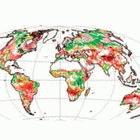15 August 2006 Scholze's team predicts more wildfires (red) if the planet warms by 3 degrees or more
Scholze's team predicts more wildfires (red) if the planet warms by 3 degrees or more
Catherine Brahic
A three-degrees Celsius rise in temperature over the next century will increase the risk of drought, wildfires and forest loss in many parts of the developing world, say researchers. Marko Scholze of the University of Bristol in the United Kingdom led an assessment of the impacts climate change could have on key ecosystems.
The study says there is a considerable risk that wildfires will be more frequent in South America, Southern Africa and Central Asia even if temperatures rise by less than two degrees.
Yet research suggested last year that a rise of two degrees was fairly certain and that an 11-degree increase was possible (see Temperature 'could rise by 11 degrees', says study).
Even if greenhouse gas emissions were to cease now, temperatures would continue to rise as heat stored in the oceans is released (see Earth is 'committed to 0.6?C of unavoidable warming').
Scholze's team warns that rising temperatures will greatly increase the risk of forest loss in Amazonia, Central America, and eastern China.
They say that if temperatures rise by more than three degrees, West Africa and Central America are likely to suffer a loss of freshwater and therefore more intense droughts.
At this level of warming, they add, the amount of carbon that trees and earth absorb is likely to be less than the amount they release into the atmosphere as carbon dioxide. This would create a strong positive feedback loop that would further increase global warming.
The researchers drew their conclusions by running 52 simulations of world climate using 16 different computer models and then used the results to predict changes to global vegetation.
They note that while they only looked at drastic changes in land-cover, from forested to non-forested and vice-versa, even more subtle changes would affect biodiversity.
Scholze says an important finding is the degree to which the effects get rapidly more pronounced with small increases in temperature.
"Most importantly," he says, "we show the steeply increasing risks, and increasingly large areas affected, associated with higher warming levels."
The researchers hope this step towards defining what constitutes "dangerous" climate change will help inform policy decisions.
Link to abstract of paper in Proceedings of the National Academy of Sciences [link will be made live by 18 August 2006]
Reference: Proceedings of the National Academy of Sciences doi 10.1071/pnas.0601816103 (2006)



